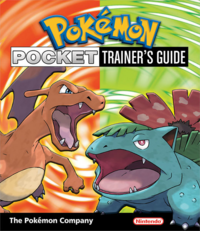Pokémon Pocket Trainer's Guide
From Bulbapedia, the community-driven Pokémon encyclopedia.
Jump to navigationJump to search
| Pokémon - Pocket Trainer's Guide | |
|---|---|

| |
| ISBN: | N/A |
| Published: | 2004 |
| Publisher: | N/A |
| Author: | N/A |
Pokémon - Pocket Trainer's Guide is a 74-page guide book for the video games Pokémon FireRed and LeafGreen. The book primarily covers game mechanics, and only lightly touches upon early-game story details. The front cover, back cover, and spine all use a shiny foil, and the book also includes a fold-out poster of Kanto, as well as a tear-out type matchup chart.
The book was originally available as a pre-order bonus with FireRed or LeafGreen.
Contents
- High Adventure in Kanto - Brief overview of the game's premise and objectives: train Pokémon, take on the Gyms, race your rival, defeat Team Rocket, and complete Professor Oak's Pokédex.
- What are Pokémon?
- Briefly describes the type triangle between Bulbasaur, Charmander, and Squirtle.
- Describes all 17 types, with 1-3 Kanto-native examples each (except for Dark, which has no examples. Steel lists its examples in text only, with no images).
- A section on Legendary Pokémon cites Articuno, Zapdos, and Moltres as examples.
- Catching Pokémon - Overview of Pokémon encounter methods, Catching mechanics, Evolution methods, and Breeding.
- Pokémon Battles - Briefly explains Pokémon stats, move stats, and type matchups, along with a type matchup chart.
- Battle Moves
- Goes over move-learning methods, stat-changing moves, and status effects
- Presents synergistic strategies in single battles, double battles, and when switching out.
- Build the Perfect Team - Shows an example of a well-rounded team, and an imbalanced team where all members are weak to Ground-type attacks.
- Pokémon League Gym Trainers - Short profiles of the eight Gym Leaders (though the Viridian City Gym Leader uses a vague description and is not named). Also has an allusion to the Rival's role.
- The Pokémon Center - Highlights the Pokémon Center's features as a rest stop, and place to store Pokémon and items.
- The Center's Wireless Features - Describes wireless connectivity methods with other players to chat, battle, and trade.
- Beyond Kanto? - Alludes to new areas such as the Sevii Islands, as well as wireless minigames such as Dodrio Berry Picking.
- The World of Connectivity - Details the connectivity features between FireRed and LeafGreen, Pokémon Ruby and Sapphire, Pokémon Box Ruby & Sapphire, and Pokémon Colosseum.
- Battle Log - Note pages to write down details of two Pokémon teams, the winner in battle between the two, and analysis.
- A tear-out type matchup chart.
- A fold-out poster of Kanto.
Trivia
- The section on the Ghost type says "You can't bust these ghosts!", referencing the 1984 supernatural comedy film Ghostbusters.
- Haunter is the only Pokémon listed in the book whose weight does not round out its decimals. Since its weight is 0.2 lbs, rounding would reduce that to 0 lbs.
- In the catching mechanics section, the book recommends using Mean Look or Block to prevent certain Wild Pokémon from escaping. However, the example image shows this being performed on a wild Sandshrew, which is not able to escape in the first place.
- The book recommends putting a Pokémon in the lead position of the party to improve its friendship - however, party position does not directly affect friendship gain. Battling a Gym Leader, Elite Four Member, or the Champion adds friendship to all party members, and walking 128 steps adds friendship to all party members - in both cases, the position of the members has no impact.
- That said, having a Pokémon in the lead position could indirectly improve friendship, as it makes certain friendship-increasing actions more likely to occur - namely, Leveling up or using a battle item on it.
- Screenshots of summary screens show two instances of low-level Pokémon that were caught in Master Balls - a Level 12 Meowth, and a Level 26 Poliwhirl.
- The Poliwhirl's Original Trainer is named Zelda.
- Even though the guide attempts to hide the identity of the Viridian City Gym Leader with shadows, his Team Rocket insignia is still visible in the provided artwork.
Errors
- Charizard is incorrectly listed as being purely Fire-type, when it is actually Fire/Flying-type.
- Nidoran♂ incorrectly lists Nidoran♀'s height and weight as its own, and vice versa.
- The book makes some erroneous claims about type matchups:
- Claims that Normal-type Pokémon resist Ghost-type attacks (they are immune to Ghost-type attacks).
- Claims that Poison-type Pokémon are immune to Poison-type attacks (they are not, however they are immune to the Poison status condition).
- Claims that Flying-type Pokémon are immune to "some" Ground-type attacks (they are immune to all Ground-type attacks).
- The book claims that the power boost from Flash Fire is available "all of the time", as opposed to abilities like Torrent that only activate while "under dire circumstances". However, Flash Fire's attack boost requires the user to be hit by a Fire-type attack before the power boost is granted. While it is true that the attack boost stays active until the user is switched out or the battle ends, it is misleading to say it is available "all the time".

|
This book article is part of Project Merchandise, a Bulbapedia project that aims to write comprehensive articles on all Pokémon toys, dolls, books, and collectible merchandise. |